|
< Earlier Kibitzing · PAGE 2 OF 2 ·
Later Kibitzing> |
| Aug-16-12 | | BishopTakes: Karpov is Positional master |
|
| Oct-23-12 | | Corry: One of best karpov's game... In this game his pieces are really untouchable from the beginning to the end . Kasparov try to attack like a child against his father ... sick! |
|
| Dec-08-12 | | whiteshark: Karpov annotates this game: http://www.youtube.com/watch?featur... |
|
| Aug-21-14 | | coldsweat: I think "later games" might be a bit of an understatement -- it took Garry thirty two games to finally win one. |
|
| Oct-09-14 | | yurikvelo: <Anatoly Eugenievitch Karpov, aka Demolition Man>
Hoidini-1st-line Man!!!
http://goo.gl/as5Dn6
Stockfish-5 analyze 28..32 plyes deep. |
|
| Feb-13-15 | | bennyvsfischer: 28.Rd7! |
|
| May-18-15 | | ToTheDeath: Yep, deadly accuracy and a Python like grip, all the hallmarks of Karpov at his best. |
|
Sep-17-17
 | | offramp: 
click for larger view
17. f2-f3! This tiny move wins the d-pawn and the game. One of Karpov's best games. |
|
| Sep-17-17 | | anjumskhan: at the end of the game, there is a line of pieces along the b file, hence the title "making the bee line". |
|
Sep-17-17
 | | MKD: What is the best continuation, if black plays Bc2? |
|
Sep-17-17
 | | offramp: <anjumskhan: at the end of the game, there is a line of pieces along the b file, hence the title "making the bee line".> There is a similar position in Larsen vs Kavalek, 1979. |
|
Sep-17-17
 | | PawnSac: < MKD: What is the best continuation, if black plays Bc2? > probably something like...
31. Bb6 Bxc2 32. Bxc7 Bxb4 33. Re8+ Bf8 34. Bc6 or Rb8 Nc5 35.Bd6 Ne6 36.Bc4 g5 37.Bxe6 fxe6 38.Rf8+ |
|
| Sep-18-17 | | kevin86: Whites's minor pieces attack, black's cower. |
|
| Sep-18-17 | | kevin86: Doesn't a bee line begin with a buzz? |
|
Oct-29-17
 | | offramp: 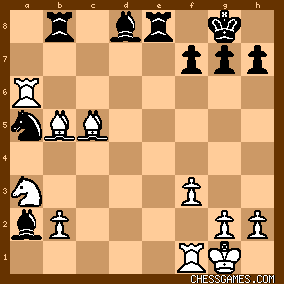
click for larger view
23... Rxb5!!
24. Nxb5 Bc4 ±.
That would have given Black some chances to save the game. |
|
| Mar-08-19 | | Momentum Man: Hi offramp!
After 28.Rd7, Black doesn't play 28...Bxc2
I assume that's because he didn't like 29.Rxe6 fxe6 30.Rxe7 But I am thinking Karpov could also play 29.Rxb7. Then 29...Rxb7 30.Ra8+ Bf8 31.Bc5 threatens mate. After 31...h5 32.Rxf8+ Kh7, White is down the exchange. So maybe there isn't enough compensation here. Originally, I was thinking 31...h5 is answered with 32.Bd3, but writing this comment made me realize 32.Bd3?? is a horrible blunder because it's en pris to the Black Bishop on c2 |
|
Mar-10-19
 | | offramp: <Momentum Man> I hadn't thought about this game in a long time. Karpov played
16. Rad1!
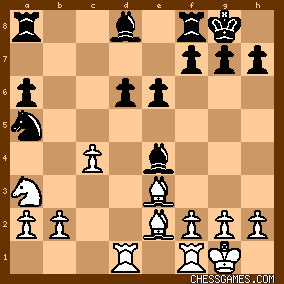
click for larger view
Kasparov thought for 50 minutes on his reply, 16...Na5, which gives up a pawn. GK thought he would get enough piece activity to win the pawn back, but that didn't happen. Karpov was too good.
*****
Karpov played the final moves with great accuracy.

click for larger view
26. Nc2.
The knight comes back into play with tempo because the ♗ on a2 is attacked.
26...Bd5.
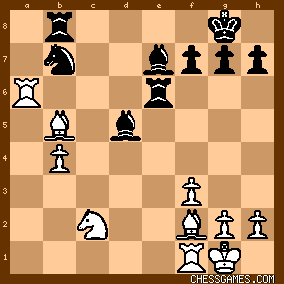
click for larger view
White has lots of available moves. Karpov plays one which seems to walk into a pin.
27. Rd1 Bb3
<Apart from ...Bxc2, Black intends ...Nd8.>
28. Rd7!
<The best move! It is not easy to see but the ♗b3 is in trouble and Na1! is threatened!>
28...Rd8
As <Momentum Man> says, 28...Bxc2 29.Rxe6 fxe6 30.Rxe7 is very bad for Black.
29. Rxe6 Rxd7.
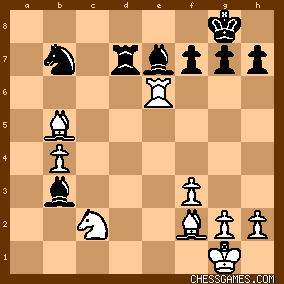
click for larger view
30. Re1! <He didn't miss Black's big threat of ...Rd1+.>
30...Rc7
31. Bb6.

click for larger view
If now 31...Rxc2 32. Rxe7 Nd6...

click for larger view
...and now 33.Bc5 or 33.Rd7 wins a piece.
Very accurate play. Karpov was at one of his career peaks at the start of this match. |
|
| Nov-18-20 | | fisayo123: Its rare to see Kasparov beaten so smoothly but Karpov makes it look easy here. In queenless middle games and endgames his play was characterized by an extreme precision that Kasparov needed time to adjust to. You can't just make any sort of slip against him or hope for any sort of mistake |
|
| Apr-22-21 | | Gaito: 
click for larger viewBLACK TO MOVE
According to the engines, Black ought to have played 21...Rxa6, with approximate equality and a likely draw as an outcome of the game. For example: 21...Rxa6 22.Bxa6 Be7 23.Nb5 (23.Rc1 also deserves attention) Nc6 24.Nc3 Be6 25.Ne4 Nb4 26.Be2 Rb8 (diagram below) 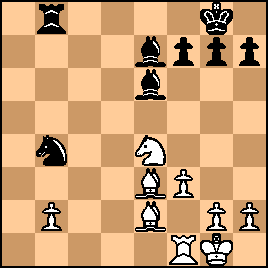
click for larger viewIn spite of having an extra pawn, White's chances of winning this ending would be very dim, almost inexistent even for an endgame genius as Anatoly Karpov, because all of Black's pieces are very well placed to prevent the advance of White's b2-pawn. Sooner or later the pawn would fall. The engines evaluate the ending as equal (SF13 gives a numerical evaluation of +0.33). |
|
| Apr-23-21 | | Gaito: 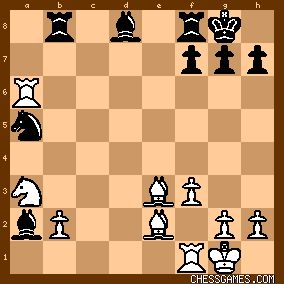
click for larger viewWHITE TO MOVE
In this position Karpov played 22.Bc5. An alternative worthy of consideration was 22.Rd1, e.g. 22...Rxb2 23.Bc5! Bb3 24.Rd4 Bf6 25.Rxf6! Rxe2 (if 25...gxf6? 26.Rg4+ leads to a quick mate) 26.Ra6 Rfe8 27.Rxa5 with an easy win for White. Very likely Karpov refrained from entering into these complicated tactical variations because he always preferred to have everything under control. Naturally enough, for a machine 22.Rd1 is the "correct" move, but for a human being 22.Bc5, as played by Karpov, should be the safest course. Why bother to complicate the game when in front of you there is a young tactical genius? |
|
| Apr-23-21 | | Gaito: 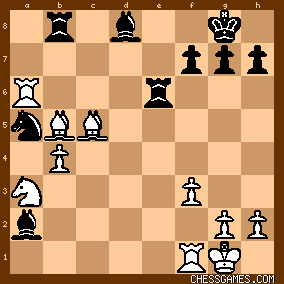
click for larger viewBLACK TO MOVE
It is not clear if Kasparov was short of time when this position was reached. The engine (SF13) suggests that Black play here 24...Nb3, and does not approve of the move 24...Nb7? A likely continuation after 24...Nb3 could be 25.Rxe6 fxe6 26.Be3 Be7 27.Bd7 (equally good would be 27.Bc4) Bxb4 28.Bxe6+ Kf8 29.Nc2 Be7 30.Nd4 Bc5 31.Nf5 Bxe3+ 32.Nxe3 Nc1 33.Rxc1 Bxe6 34.Kf2 (see diagram below): 
click for larger viewThis is the sort of ending where the advantage of a pawn is almost of no significance, and a draw should be the likely outcome. |
|
| Sep-30-21 | | Gaito: 
click for larger view
BLACK TO MOVE
According to the engines, Black ought to have played 21...Rxa6, with approximate equality and a likely draw as an outcome of the game. For example: 21...Rxa6 22.Bxa6 Be7 23.Nb5 (23.Rc1 also deserves attention) Nc6 24.Nc3 Be6 25.Ne4 Nb4 26.Be2 Rb8 (See diagram below):

click for larger view
In spite of having an extra pawn, White's chances of winning this ending would be very dim, almost inexistent even for an endgame virtuoso as Anatoly Karpov, because all of Black's pieces are very well placed to prevent the advance of White's b2-pawn. Sooner or later the pawn would fall. The engines evaluate the ending as equal (SF14 gives a numerical evaluation of +0.33). |
|
| Sep-30-21 | | Gaito: 
click for larger view
BLACK TO MOVE
It is not clear if Kasparov was short of time when this position was reached. The engine (SF13) suggests that Black play here 24...Nb3, and does not approve of the move 24...Nb7? A likely continuation after 24...Nb3 could be 25.Rxe6 fxe6 26.Be3 Be7 27.Bd7 (equally good would be 27.Bc4) Bxb4 28.Bxe6+ Kf8 29.Nc2 Be7 30.Nd4 Bc5 31.Nf5 Bxe3+ 32.Nxe3 Nc1 33.Rxc1 Bxe6 34.Kf2 (see diagram below):

click for larger view
This is the sort of ending where the advantage of a pawn is almost of no significance, and a draw should be the likely outcome. |
|
| Dec-29-21 | | Heidi Baxendale: This is Karpov's first win in this match and looks like he played very accurately his WEV score here is a very impressive 0.07 (a perfect score is 0) and Kasparov scored a 0.39. After the first three games Karpov's WEV average is 0.21 and Kasparov's slightly less accurate with 0.31. <Gaito> is correct Kasparov blundered with 21...Rb8?? necessary was 21...Rxa6 and black should hold. Karpov missed 22.Rd1! Be6 23.b4 and white should win. Kasparov blundered with 24...Nb7?? and Karpov didn't let the win slip away from him this time. |
|
Nov-26-22
 | | kingscrusher: <whiteshark> It doesn't get better than Karpov explaining a critical win against Kasparov in a world championship match - many thanks for that Youtube video link: https://www.youtube.com/watch?v=76W... |
|
 |
|
< Earlier Kibitzing · PAGE 2 OF 2 ·
Later Kibitzing> |





































